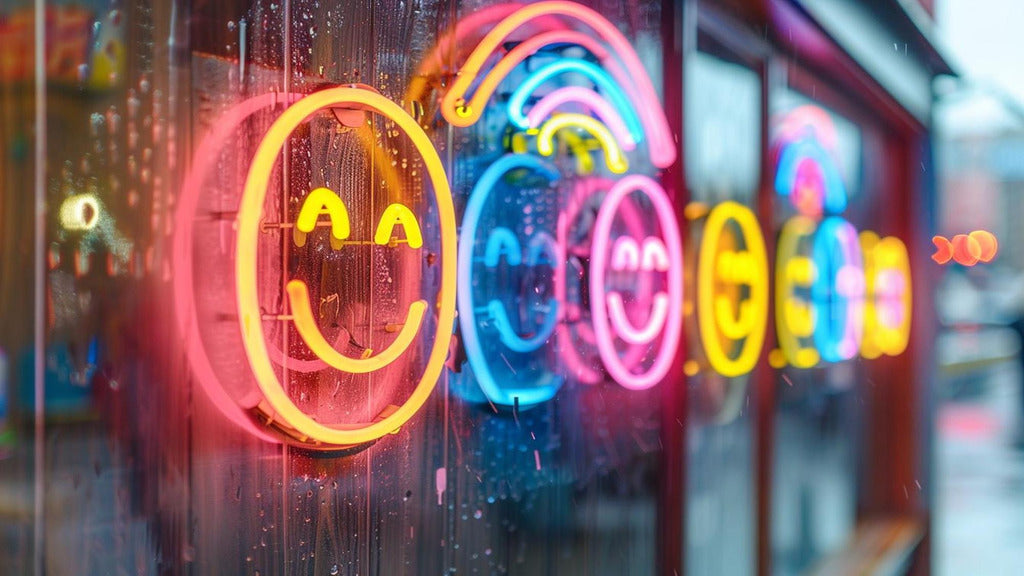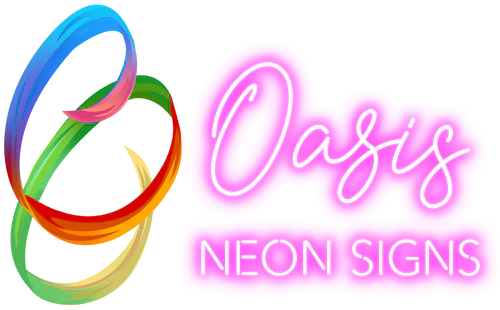
How Do Neon Signs Have Different Colors
Share
How do neon signs have different colours? It’s the question every neon lover has asked themselves at some point in time. If you’ve just discovered your love for these glowing beauties and becoming more inquisitive about why they are the way they are, you’ve just come to the right place. As you might have noticed, neon colours seem more striking than the rest. They quickly grasp your attention even at a distance. And that’s why the vibrant neon colour spectrum makes any neon sign design stand out without hurting the eyes.
With a bit of artistry, when used sparingly and carefully, the neon signs gas colour chart can give birth to attractive signs that add energy and excitement to any space. Here, we’ve addressed most of your concerns about the different colours neon signs can have. Read through to enhance your knowledge of neon sign colours and become a seasoned guru in the world of neon.
The Basics of Neon Signs
Neon signs have jazzed up businesses and streets since the 1920s, and in this age of photos and social media, they’ve become much more popular. They’re the flashy, striking tubes of light that scream, “Look at me!” But what makes them that much attractive? Well, it all begins with a simple gas-filled glass tube.
It’s All About The Noble Gases

When neon signs come to mind, you may picture a sign with a classic reddish-orange glow. The colour magic is due to pure neon gas. But how do neon sign makers get the other vibrant colours? Well, the different colours are because of different noble gases that glow when heated. Here’s a summary of the colours that these noble gases produce:
- Neon gas: This is the star of them all. Neon gas gives off a reddish-orange hue.
- Helium: Helium glows in a bright orange colour.
- Krypton gas: Although krypton is a bit rare, it can produce a range of colours, from pale lavender to white.
- Argon gas: When paired with a drop of mercury, argon glows in a bright blue colour.
- Xenon gas: Xenon is yet another noble gas that glows in lavender or blue when heated.
These noble gases make the primary players in the neon sign colour gases, but that’s not all. When looking at neon colours, they have a glow that’s different from conventional colours. That’s because they absorb more heat and reflect more as light.
They have luminescent pigments and the colours come out only when light descends on the spectrum that’s visible to the human eye. Invisible ultraviolet rays create an additional beautiful glow in neon colours, helping have a more intense look.
The Colour Chart: Beyond The Noble Gases
So, we’ve got our noble gases figured out, but you may still be wondering how do neon signs have different colours. How do we move from a handful of colours to the wide rainbow spectrum of colours you see out in the streets? The secret is in the combination of gases, phosphor coatings, and coloured glass tubes.
Phosphor Coatings
These are like the secret sauce in neon signs that create vivid glows you see. When applied to the inner part of the glass tube, they have the power to transform the light from the heated gas into a striking colour. With that said, phosphor coatings can be of different types:
- Argon and Phosphor Coating: By itself, Argon gives off a blue glow but coating the glass tube’s inner part with phosphor can transform that light into any colour, from yellow, green, to pink.
- Krypton and Phosphor Coating: Krypton produces a spectrum of colours when paired with phosphor coating, therefore expanding the colour palette even more.
That’s how phosphor coatings contribute in making different neon signs using various gases.
Coloured Glass Tubes

That striking neon colour you see on neon signs when you walk the busy streets of London are mainly achieved through coloured glass tubes. It’s a simple solution that gives birth to a somewhat complex but striking beauty. From the coloured glass tubes, you can achieve the colour desired.
A red glass tube filled with argon gas will produce a deep, rich red glow while a neon-filled blue glass tube gives off a striking blue. Here’s a neon signs gas colour chart showing the additional range of colours that can be made with coloured glass tubes:
|
Noble Gas |
Colour Without Coloured Glass |
Colour With Coloured Glass |
|
Neon |
Reddish-orange |
Different shades with coloured glass |
|
Argon |
Blue |
Yellow, Green, Pink with phosphor coating |
|
Krypton |
White to Lavender spectrum |
Different shades with phosphor |
|
Xenon |
Blue to Lavender |
Different shades with phosphor |
The Magic of Mixing Gases
To further answer the question “how do neon signs have different colours,” we also need to look at how combining gases produces the different glows. Some neon signs can employ a mixture of different gases to produce even more striking colour shades. For instance, neon when combined with argon gas produces beautiful shades of purples and pinks.
When argon is combined with krypton, they can produce subtle pastel colours. These are the soft glows you’d find in neon signs exuding romance. Mixing gases allow neon sign makers to come up with an even broader colour spectrum, making neon signs one of the most versatile forms of lightning in the market today.
The Magic Behind the Neon Glow
Now, we’ve addressed the question of how the colours come about. But how exactly does the actual glowing take place? Well, in simple terms without going deeper into the technicalities, the gas glow when electric current passes through the airtight glass tube. Each end of the glass is sealed with a metallic electrode to create a path for the electricity.
A high voltage ionises the noble gas atoms, making them produce energy in the form of light. The colour produced will generally depend on the noble gas used and whether the glass is coloured or coated.
Neon Light Colour Code

Do you want a specific colour of your brand in your neon sign? There’s a neon version of literally every conventional colour, and below are some of the neon light colour codes of the main ones:
|
Neon Colour Group |
Colour Name |
Colour Codes |
|
Neon Reds |
Neon red |
HEX #ff313, RGB 255, 49, 49, CMYK 0, 81, 81, 0 |
|
Electric orange |
HEX #ff5e00, RGB 255, 94, 0, CMYK 0, 63, 100, 0 |
|
|
Neon Blues |
Neon blue |
HEX #1f51ff RGB 31, 81, 255 CMYK 88, 68, 0, 0 |
|
Electric blue |
HEX #0ff0fc, RGB 15, 240, 252, CMYK 94, 5, 0, 1 |
|
|
Neon Greens |
Neon green |
HEX #39ff14 RGB 57, 255, 20 CMYK 78, 0, 92, 0 |
|
Electric lime |
HEX #ccff00 RGB 204, 255, 0 CMYK 20, 0, 100, 0 |
|
|
UFO green |
HEX #7fff00 RGB 127, 255, 0 CMYK 50, 0, 100, 0 |
If you’re looking for a way to create electrifying ad material for your newsletters, marketing ads, or social media posts, consider using neon colours. By varying the three main colours, you can achieve almost any neon colour variant you need. Of course, with the help of the colour codes.
Understanding neon sign colour psychology can further enhance your message, as each colour triggers specific emotions—like red for excitement, yellow for optimism, or green for relaxation—making your content more impactful and engaging.
The Modern LED Neon Signs Colour Spectrum Comparison
For years, the world knew of the traditional glass tube neon signs, until the LED technology arrived. As we march into a brighter future, LED neon signs have increasingly become popular for their efficiency, ease of maintenance, and lower running costs. They’re giving the traditional glass tube neon signs a run for their money, providing a vibrant colour spectrum. Due to the array of benefits of LED neon signs, Oasis Neon Signs adopted them to supply you with the best quality and more affordable neon signs.
So, how do these LED neon signs produce a wide colour spectrum when compared to their noble gas-filled predecessors?
LED Neon Colour Spectrum
When considering the different colours neon signs can have, LED neon signs are highly versatile. Unlike their traditional counterparts that rely on gases and glass coatings, LED neons combine red, green, and blue (RGB) diodes to come up with a full spectrum of attractive colours.
Each LED neon contains a red, green, and blue light diode. When the colour intensity of these diodes are adjusted, the LED sign can produce any colour in the spectrum. Mixing the different intensities of these colours, it’s possible to achieve a wider range of colours. For instance, at full intensity, a red-green combination produces yellow, while red and blue generates a purple glow.
What about white glow, how are they produced? Well, to produce pure white, LED neon signs often use phosphor coatings to change blue glow into white.
How LED Neon Signs Change Colour
You’ve probably seen the interactive LED neon signs that change colour according to the motion or sound detected. They’re the modern alternative to the gas-filled glass neon signs, making them suitable for home décor, events, and business applications. LED neon signs are equipped with intelligent LED chips that allow them to change the colours for aesthetics.
This makes them more dynamic and appealing. So, if you were wondering how do neon signs have different colours, well, LED neon signs can do much more than changing colours. They can produce pulsating, flashing, or flickering glows and be able to adjust the brightness with the use of a simple button remote control.
Traditional Gas-Filled vs. LED Neon Signs

So, when shopping around for a neon sign, which should you consider between the gas-filled glass neon and LED neon signs? Here’s a breakdown of the major differences between these two dazzles to see how they compare in terms of colour versatility and overall performance.
|
Feature |
Gas-Filled Glass Neon Signs |
LED Neon Signs |
|
Colour Spectrum |
Limited by type of gas and coatings |
Can achieve a wider spectrum through RGB technology. |
|
Customisability |
It’s limited to bending of glass |
It can have highly flexible, intricate designs. |
|
Durability |
Fragile glass tubes |
Flexible, shatterproof materials with acrylic backing. |
|
Energy Efficiency |
High energy consumption |
Lower energy consumption |
|
Safety |
Uses high voltage and produces more heat |
Uses low voltage and produces little to no heat. |
|
Maintenance |
Requires servicing regularly by a professional |
Easy to maintain. |
|
Initial Cost |
Expensive due to the glass bending artisanry and the noble gases. |
Often cheaper due to the materials and applicable technologies. |
From this comparison, it’s evident that LED neon signs take the day for their flexibility and ability to produce a much wider colour spectrum. So, if you need a neon sign that can give your space a modern elegant look, more affordable, and easy to maintain, LED neon signs are the answer. But if you want a classic vintage vibe with nostalgic charm, the traditional neon signs are worth considering.
Wrapping Up: The Glow Goes On
Every neon sign enthusiast who’s been wondering how do neon signs have different colours, you’ll find your answers in this comprehensive post. The beauty of neon is one of a kind and has a nostalgic effect that can transform any space. What makes neon signs worth every penny is the striking beauty of neon colours.
You’re welcome to combine different neon colours to come up with more electrifying visuals. Alternatively, you can balance their brightness with more neutral glows to give your space a striking appeal that your audience will resonate with.
Got a neon sign idea in mind that you’d like to bring to life? Now start creating your neon sign with the Oasis Neon Signs free design tool.

